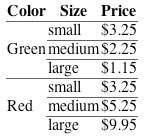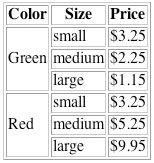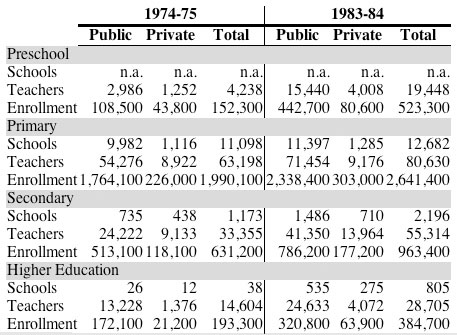Tagging Tables
Table, Table Wrapper, and Table Group
There are three similar sounding elements for tagging tables:
The element containing the rows and columns of tabular table material. The Tag Suite default element is <table>, taken from the NISO JATS XHTML-inspired table model. | |
Element that represents the complete table. This includes the row-and-column data, table number, table caption including the table title, and any table footnotes or general notes attached to the table. If the complete table includes a label (such as “Table 3”) and it should appear in a List of Tables for the publication, then it is tagged with the <table-wrap> element. |
Table Wrapper
Simply put, the <table-wrap> is a container for tables. Here is a <table-wrap> element that contains nothing but a NISO JATS <table> element inside it:
... <table-wrap> <table frame="box"> <thead> <tr> <th>Color</th> <th>Size</th> <th>Price</th> </tr> </thead> <tbody> <tr> <td rowspan="3">Green</td> <td>small</td> <td>$3.25</td> </tr> <tr> <td>medium</td> <td>$2.25</td> </tr> <tr> <td>large</td> <td>$1.15</td> </tr> <tr> <td rowspan="3">Red</td> <td>small</td> <td>$3.25</td> </tr> <tr> <td>medium</td> <td>$5.25</td> </tr> <tr> <td>large</td> <td>$9.95</td> </tr> </tbody> </table> </table-wrap> ...
The <table-wrap> element also provides a uniform place to put information such as a table number (<label>) and table title and caption (both in <caption>). The element <table-wrap> can also contain a Table Wrapper Footer, as a place to put table footnotes and other information.
<table-wrap id="Table-07">
<caption>
<title>2008 Expenditures</title>
<p>Total research expenditures by disease, 2008</p>
</caption>
<table>…</table;>
<alt-text>Distribution of research spending for major
diseases.</alt-text>
<object-id>314159</object-id>
</graphic>
<attrib>Reprinted courtesy of TableSource, Inc.</attrib>
</table-wrap>
Nested Tables
The table models in the JATS do not allow nested tables. That is, a table cell (e.g., <td>) may not contain a table.
Non-tabular Tables
It is possible that a <table-wrap> will not contain a <table> element at all, since objects that are identified as tables need not contain tabular material. While a <table-wrap> may contain the rows and columns of a table element as just shown (using the NISO JATS XHTML-inspired Table <table> model); a table may also contain:
- only one or more graphics,
- a bulleted or numbered list,
- a definition list,
- paragraphs of material, or
- a mixture of these elements.
Here is a table that has no tabular material in it because the tabular portion is represented as a graphic:
<table-wrap id="Table-07">
<caption>
<title>2008 Expenditures</title>
<p>Total research expenditures by disease, 2008</p>
</caption>
<graphic xlink:href="totals.jpeg">
<alt-text>Distribution of research spending for major
diseases.</alt-text>
<object-id>314159</object-id>
</graphic>
<attrib>Reprinted courtesy of TableSource, Inc.</attrib>
</table-wrap>
Here is another non-tabular table:
<table-wrap id="Table-05">
<caption>
<title>Show and Tell Program</title>
</caption>
<list list-type="order">
<list-item><p>Poodle</p></list-item>
<list-item><p>Persian Cat</p></list-item>
<list-item><p>Weaver Finches</p></list-item>
<list-item><label>4.</label><p>Gecko</p></list-item>
</list>
<attrib>Reprinted courtesy of YourSchool.edu</attrib>
<permissions>
<copyright-statement>© 2008</copyright-statement>
</permissions>
</table-wrap>
Some complex tables may consist of a single table wrapper (Table Wrapper) containing a one or more small tables that represent one logical tabular area. For example, one part of the display might be 3 rows by 10 columns, the next part might be 5 rows by 2 columns, and the last part may return to 10 columns for 6 more rows. Each tabular area can be tagged with a NISO JATS Table (NISO JATS table model) element, and paragraphs of text may be interspersed between the tabular material. In the United States, tax tables are frequently this type of table.
Table Formatting
By default, this Tag Set uses the NISO JATS XHTML-inspired table model (based on and designed to be converted easily to the XHTML 1.1 Table Model). This model matches the needs of web browsers and can support (at least roughly) most table display formatting.
Format is indicated in one of two ways in NISO JATS default table: using multiple single-purpose attributes for simple formatting, or making more complex formats using the @style attribute.
Simple Formatting with Attributes
Simple format information can be indicated with the following attributes:
- @border controls borders around all of the cells in a table,
- @cellpadding controls space between the text and any borders in the cells of the table,
- @cellspacing controls space between the cells of the table,
- @frame controls the “box” around the whole table,
- @rules controls rules between groupings in the table (rows, columns, column groups, etc.), and
- @width controls the width of the entire table or columns within the table.
To illustrate use of the @rules attribute, here is a table with rules on the rows:
... <table-wrap> <table rules="rows"> <thead> <tr> <th>Color</th> <th>Size</th> <th>Price</th> </tr> </thead> <tbody> <tr> <td rowspan="3">Green</td> <td>small</td> <td>$3.25</td> </tr> <tr> <td>medium</td> <td>$2.25</td> </tr> <tr> <td>large</td> <td>$1.15</td> </tr> <tr> <td rowspan="3">Red</td> <td>small</td> <td>$3.25</td> </tr> <tr> <td>medium</td> <td>$5.25</td> </tr> <tr> <td>large</td> <td>$9.95</td> </tr> </tbody> </table> </table-wrap> ...

Here is the same table, without the rules, to demonstrate use of the @frame attribute:
... <table-wrap> <table frame="box"> <thead> <tr> <th>Color</th> <th>Size</th> <th>Price</th> </tr> </thead> <tbody> <tr> <td rowspan="3">Green</td> <td>small</td> <td>$3.25</td> </tr> <tr> <td>medium</td> <td>$2.25</td> </tr> <tr> <td>large</td> <td>$1.15</td> </tr> <tr> <td rowspan="3">Red</td> <td>small</td> <td>$3.25</td> </tr> <tr> <td>medium</td> <td>$5.25</td> </tr> <tr> <td>large</td> <td>$9.95</td> </tr> </tbody> </table> </table-wrap> ...

And here is the @border attribute:
...
<table-wrap>
<table border="1">
<thead>
<tr>
<th>Color</th>
<th>Size</th>
<th>Price</th>
</tr>
</thead>
<tbody>
<tr>
<td rowspan="3">Green</td>
<td>small</td>
<td>$3.25</td>
</tr>
<tr>
<td>medium</td>
<td>$2.25</td>
</tr>
<tr>
<td>large</td>
<td>$1.15</td>
</tr>
<tr>
<td rowspan="3">Red</td>
<td>small</td>
<td>$3.25</td>
</tr>
<tr>
<td>medium</td>
<td>$5.25</td>
</tr>
<tr>
<td>large</td>
<td>$9.95</td>
</tr>
</tbody>
</table>
</table-wrap>
...

Formatting with Style
All the tables just shown are all relatively simple formats. More complex table formatting is done using the @style attribute, which contains CSS instructions. Key to understanding how the CSS in tables works is that instructions on smaller portions override those on larger portions of the table. For example, if a background color is provided for the whole table and different background color is specified for a row, everything in the table will be the first background color except that row, which will have the second. Similarly, if borders are specified for a <colgroup>, they will apply to the whole <colgroup> unless a different border is specified for one cell (<th> or <td>), in which case that cell will have the override.
Here is a sample, in code and image, of a relatively complex table, formatted using a variety of techniques including CSS in the @style attribute, controlling alignment with the @align attribute, and a few spans.
... <table-wrap> <table rules="groups" > <colgroup style="border-right: hidden"><col/></colgroup> <colgroup style="border-right: solid thin"><col/><col/><col/></colgroup> <colgroup><col/><col/><col/></colgroup> <tr> <th></th> <th colspan="3" style="border-bottom: solid">1974-75</th> <th colspan="3" style="border-bottom: solid">1983-84</th> </tr> <tr> <th></th> <th style="border-bottom: solid thin">Public</th> <th style="border-bottom: solid thin">Private</th> <th style="border-bottom: solid thin">Total</th> <th style="border-bottom: solid thin">Public</th> <th style="border-bottom: solid thin">Private</th> <th style="border-bottom: solid thin">Total</th> </tr> <tr> <td style="background: lightgrey" colspan="7">Preschool</td> </tr> <tr> <td>Schools</td> <td align="right">n.a.</td> <td align="right">n.a.</td> <td align="right">n.a.</td> <td align="right">n.a.</td> <td align="right">n.a.</td> <td align="right">n.a.</td> </tr> <tr> <td>Teachers</td> <td align="right">2,986</td> <td align="right">1,252</td> <td align="right">4,238</td> <td align="right">15,440</td> <td align="right">4,008</td> <td align="right">19,448</td> </tr> <tr> <td>Enrollment</td> <td align="right">108,500</td> <td align="right">43,800</td> <td align="right">152,300</td> <td align="right">442,700</td> <td align="right">80,600</td> <td align="right">523,300</td> </tr> <tr> <td style="background: lightgrey" colspan="7">Primary</td> </tr> <tr> <td>Schools </td> <td align="right">9,982</td> <td align="right">1,116</td> <td align="right">11,098</td> <td align="right">11,397</td> <td align="right">1,285</td> <td align="right">12,682</td> </tr> <tr> <td>Teachers</td> <td align="right">54,276</td> <td align="right">8,922</td> <td align="right">63,198</td> <td align="right">71,454</td> <td align="right">9,176</td> <td align="right">80,630</td> </tr> <tr> <td>Enrollment</td> <td align="right">1,764,100</td> <td align="right">226,000</td> <td align="right">1,990,100</td> <td align="right">2,338,400</td> <td align="right">303,000</td> <td align="right">2,641,400</td> </tr> <tr> <td style="background: lightgrey" colspan="7">Secondary</td> </tr> <tr> <td>Schools</td> <td align="right">735</td> <td align="right">438</td> <td align="right">1,173</td> <td align="right">1,486</td> <td align="right">710</td> <td align="right">2,196</td> </tr> <tr> <td>Teachers</td> <td align="right">24,222</td> <td align="right">9,133</td> <td align="right">33,355</td> <td align="right">41,350</td> <td align="right">13,964</td> <td align="right">55,314</td> </tr> <tr> <td>Enrollment</td> <td align="right">513,100</td> <td align="right">118,100</td> <td align="right">631,200</td> <td align="right">786,200</td> <td align="right">177,200</td> <td align="right">963,400</td> </tr> <tr> <td style="background: lightgrey" colspan="7">Higher Education</td> </tr> <tr> <td>Schools</td> <td align="right">26</td> <td align="right">12</td> <td align="right">38</td> <td align="right">535</td> <td align="right">275</td> <td align="right">805</td> </tr> <tr> <td>Teachers</td> <td align="right">13,228</td> <td align="right">1,376</td> <td align="right">14,604</td> <td align="right">24,633</td> <td align="right">4,072</td> <td align="right">28,705</td> </tr> <tr> <td>Enrollment</td> <td align="right">172,100</td> <td align="right">21,200</td> <td align="right">193,300</td> <td align="right">320,800</td> <td align="right">63,900</td> <td align="right">384,700</td> </tr> </table> </table-wrap> ...

Table Models
By default, this Tag Set uses the NISO JATS XHTML-inspired table model, as defined in the NISO JATS XHTML Table Module.
NISO JATS XHTML-inspired Table. The modules that implement the NISO JATS XHTML-inspired table coding are:
- NISO JATS XHTML-inspired Table Setup Module (JATS-XHTMLtablesetup1.ent) Sets all parameter entities
needed by the NISO JATS table model, and then references (invokes) the NISO JATS XHTML-inspired Table Module. (See next item.)
To include the NISO JATS XHTML-inspired table model in a tag set, a DTD must reference this module. - NISO JATS XHTML-inspired Table Module (xhtml-table-1.mod) The NISO JATS XML DTD version of the XHTML Tables Module, which contains the NISO JATS version of the W3C-developed XHTML table model. This module is invoked from the module %XHTMLtablesetup.ent;. (See previous item.)
- NISO JATS XHTML-inspired Table Style Module (xhtml-inlstyle-1.mod) Declares the @style attribute, which supports inline style markup for elements such as <td> and <tr> within NISO JATS XHTML-inspired table.